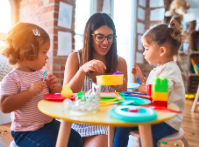Building a classroom where every child feels valued begins with understanding and respecting the diverse backgrounds that students bring with them each day. A culturally responsive classroom nurtures inclusion, fosters empathy, and helps students thrive both socially and academically.
Why Cultural Responsiveness Matters
Children come from a variety of cultural experiences, family traditions, and worldviews. When these differences are acknowledged and celebrated, students feel seen and respected. This sense of belonging leads to better engagement, stronger relationships, and a deeper appreciation for learning.
Practical Ways to Foster Inclusivity
-
Know Your Students
Take time to learn about each child’s cultural background, languages spoken at home, and family customs. This knowledge provides a strong foundation for building meaningful connections. -
Diversify Your Materials
Include books, images, and learning resources that reflect a wide range of cultures and experiences. Representation helps children see themselves in the curriculum and broadens everyone’s understanding of the world. -
Celebrate Traditions and Holidays Thoughtfully
Incorporate celebrations and discussions that highlight various cultural holidays. Invite families to share stories or activities related to their traditions, creating a richer classroom experience. -
Encourage Open Dialogue
Create a safe space where children can ask questions and express their ideas. Guided discussions on topics like fairness, kindness, and respect help young learners become more empathetic and open-minded. -
Adapt Teaching Styles
Recognize that children may have different communication styles or learning preferences based on their cultural backgrounds. Flexible teaching strategies allow all students to feel included and supported.
Supporting Growth Through Respect
A culturally responsive classroom doesn’t happen overnight—it’s an ongoing journey of listening, learning, and growing. When educators model curiosity and respect, children naturally follow. This nurturing environment allows every learner to feel confident and accepted.
Final Thoughts
Creating a culturally responsive classroom is about more than lesson plans—it’s about building relationships and honoring each child’s identity. By doing so, we empower students to appreciate diversity and contribute to a more compassionate world.


